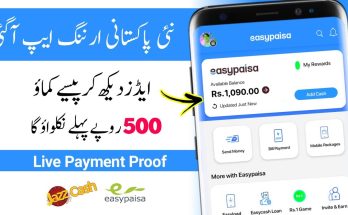Introduction:
In today’s digital age, there are countless opportunities for individuals to harness their skills and expertise to earn money. Freelancing apps have emerged as a popular platform for connecting freelancers with clients from around the world. Whether you’re a writer, designer, programmer, or possess any marketable skill, freelancing apps offer a flexible and accessible way to monetize your talents. In this guide, we’ll explore the steps to start earning through freelancing apps.
1. Choose Your Niche:
The first step in freelancing is to identify your area of expertise or passion. Consider what skills you possess and what services you can offer. This could range from writing and graphic design to web development, digital marketing, or even virtual assistance. Focusing on your strengths will make it easier to find clients.
2. Research Freelancing Apps:
There are various outsourcing applications accessible, each with its own elements and client base. A few well known choices incorporate Upwork, Consultant, Fiverr, and Toptal. Research these stages to grasp their assets, expenses, and the sorts of positions accessible. Pick the one that adjusts best to your abilities and objectives.
3. Create a Winning Profile:
Your freelancing profile is your digital resume. Craft a professional and compelling profile that showcases your skills, experience, and portfolio. Use high-quality photos, write an engaging bio, and list your skills in detail. Highlight any relevant certifications or previous work.
4. Bidding and Proposals:
On most outsourcing applications, you’ll have to offer on projects or send recommendations to clients. Create customized recommendations for each occupation you’re keen on, showing how you’re really great fit for the task. Be compact, clear, and expert in your correspondence.
5. Build a Portfolio:
A strong portfolio is crucial for attracting clients. Start by taking on smaller projects to build your portfolio, even if they pay less initially. As you gain experience and positive reviews, you can increase your rates and land higher-paying gigs.
6. Deliver High-Quality Work:
Reliably conveying quality work is fundamental for specialists. Fulfill time constraints, discuss actually with clients, and surpass their assumptions whenever the situation allows. Blissful clients are bound to give positive audits and rehash business.
7. Networking and Client Relations:
Constructing long haul client connections is critical to a fruitful outsourcing profession. Discuss transparently with clients, request criticism, and deal extra administrations when suitable. Informal proposals can prompt more open doors.
8. Manage Finances and Taxes:
Consultants are answerable for dealing with their funds and assessments. Monitor your pay and costs, put away a part of your profit for charges, and consider talking with a duty expert to guarantee consistence.
9. Continuous Learning:
The independent business is continually developing. Remain refreshed with industry patterns, new advancements, and arising abilities to stay cutthroat. Put resources into your expert improvement to extend your administration contributions.
1. Choose the Right Freelancing App:
The first step is to select a freelancing app with a robust affiliate marketing program. Some popular freelancing platforms, such as Upwork, Freelancer, and Fiverr, offer affiliate programs. Research these programs and choose the one that aligns with your target audience and interests.
2. Sign Up for the Affiliate Program:
Once you’ve chosen a freelancing app with an affiliate program, sign up for the program. This usually involves creating an affiliate account, agreeing to the program’s terms and conditions, and gaining access to unique referral links or promotional materials.
3. Understand Commission Structure:
Each freelancing app may have a different commission structure. Some offer a one-time commission for every new user or client referred, while others provide ongoing commissions based on the referred user’s spending or earnings on the platform. Understand the commission rates and terms associated with the program.
4. Promote Your Affiliate Links:
To start earning commissions, promote your affiliate links strategically. You can share these links through various channels, including your website, blog, social media, email newsletters, and even in your freelancing profiles. Craft compelling content that encourages users to click on your links.
5. Target Your Audience:
Identify your target audience and tailor your affiliate marketing efforts accordingly. For example, if you specialize in graphic design, you can target businesses and entrepreneurs looking for design services. Highlight the benefits of the freelancing app for your audience.
6. Provide Value Through Content:
Create informative and valuable content that educates potential users about the freelancing app’s features, benefits, and how it can solve their problems. Content can include blog posts, video tutorials, case studies, or success stories.
7. Track Your Referrals:
Most freelancing app affiliate programs offer tracking tools that allow you to monitor the performance of your referrals. Keep an eye on the number of clicks, sign-ups, and commissions earned. This data will help you optimize your affiliate marketing strategy.
8. Comply with Guidelines:
Ensure that you adhere to the affiliate program’s guidelines and ethical practices. Avoid spammy or misleading promotion tactics, as these can harm your reputation and lead to account suspension.
9. Optimize and Scale:
As you gain experience, continuously optimize your affiliate marketing efforts. Experiment with different promotional methods, analyze what works best, and scale your efforts to reach a wider audience.
Withdrawing your earnings from freelancing apps typically involves several steps, and the specific methods available may vary depending on the platform you’re using. Here’s a general guide on how to withdraw your earnings from a freelancing app:
1. Log In to Your Freelancing Account:
Access your freelancing account on the platform you use. Make sure you’re logged in and have completed any necessary verification steps.
2. Check Your Earnings:
Before withdrawing, ensure that you have a sufficient balance in your account. Review your earnings, taking into account any fees or charges that may apply to withdrawals.
3. Navigate to the Withdrawal Section:
Most freelancing platforms have a dedicated section or dashboard for withdrawals or payouts. Look for a “Withdraw,” “Payout,” or “Earnings” tab in your account dashboard.
4. Choose Your Withdrawal Method:
Select the withdrawal method that suits your preferences and is available on the platform. Common withdrawal methods include:
-
Bank Transfer:
-
You can link your bank account to your freelancing account and transfer your earnings directly to your bank.
-
PayPal:
-
If the platform supports PayPal, you can link your PayPal account and transfer funds there.
-
Payoneer:
-
Some freelancing apps partner with Payoneer to offer international payment options. You can create a Payoneer account and link it to your freelancing account.
-
Skrill:
-
Skrill is another payment service that is sometimes supported for withdrawals.
-
Check or Wire Transfer:
-
In some cases, you may have the option to receive a paper check or wire transfer.
-
Mobile Wallets:
-
Depending on your location and the platform, you might be able to withdraw to a mobile wallet like Venmo or Cash App.
5. Provide Required Information:
Depending on the chosen withdrawal method, you may need to provide additional information, such as bank account details, PayPal email address, or other relevant details. Follow the platform’s instructions carefully.
6. Confirm and Review:
Double-check the withdrawal details, including the amount you want to withdraw and the selected withdrawal method. Ensure that all information is accurate to avoid any issues.
7. Initiate the Withdrawal:
Click the “Withdraw” or “Submit” button to initiate the withdrawal. The platform will process your request.
8. Wait for Processing:
The processing time for withdrawals varies depending on the platform and the chosen withdrawal method. Some withdrawals are processed instantly, while others may take several business days.
9. Verify and Receive Funds:
Check your chosen withdrawal method for the arrival of funds. Be aware of any fees that may be deducted during the withdrawal process.
10. Keep Records:
It’s essential to keep records of your withdrawals for accounting and tax purposes. Many freelancers find it helpful to maintain a spreadsheet or ledger of their earnings and withdrawals.
Download
Conclusion:
Freelancing apps provide a gateway to financial independence and the opportunity to do work you’re passionate about. By choosing the right platform, honing your skills, and providing exceptional service, you can turn your freelancing endeavors into a sustainable source of income. Start your freelancing journey today and unlock the potential to earn from your expertise.




